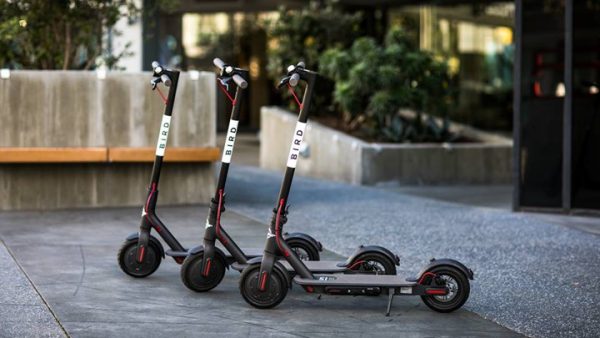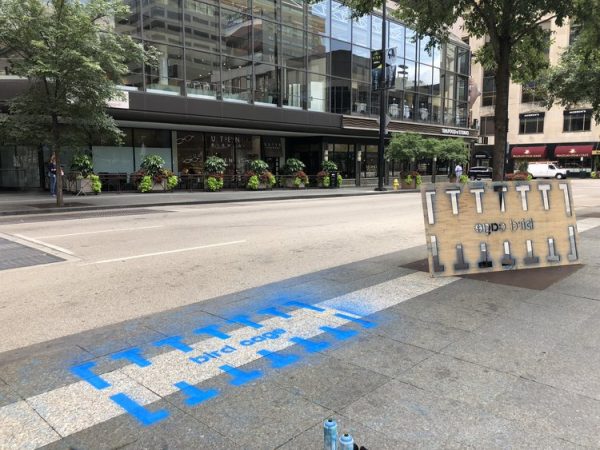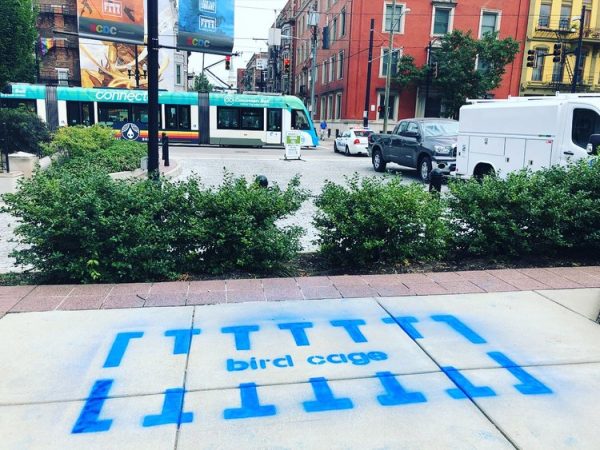Across the United States, electric scooters have been springing up overnight on city streets and sidewalks, leading to a combination of praise and condemnation from urban dwellers and local municipalities.
Deployed by a growing array of companies, these e-scooters have been lauded by some as compact, low-energy, eco-friendly, on-demand transportation but also criticized for a variety of reasons, including the ways they can obstruct (and in some cases: outright block) sidewalks.
Cities are weighing responses, from taxation and regulation to outright bans. Even areas that want to give scooters a shot are struggling to adapt quickly to their introduction. Meanwhile, though, a tactical urban design group called YARD & Company has jumped in and taken action on the streets of Cincinnati with their ‘Bird Cages‘ project (a reference to Bird, one of the various companies in the e-scooter market).
YARD’s philosophy, in short, is to embrace new options, rapidly prototype solutions, and leverage resulting data to build better infrastructure. In this case, their spray-painted parking spots offer a cheap, easy and quick solution for arraying scooters in a more orderly fashion, all without adding any substantial physical infrastructure.
“Last week, with a tiny budget and a little bit of creativity,” explains the group, “we installed Bird Cages in public spaces around downtown Cincinnati in a matter of hours. The goal was to spur creative thinking around how cities can smartly adapt and grow with new technology like Bird scooters,” founded by a former Uber and Lyft executive.
To some critics, electric scooters still invite danger, though, since many riders are new to the vehicles, which can lead to crashes and collisions. Others fail to wear helmets (even in states where they are legally required) or illegally ride them on sidewalks (in states where they are supposed to ride on streets). Scooters have also been impounded for blocking building entries, garage doors, sidewalks and curb cuts, posing issues for accessibility beyond the simple nuisance of clutter.
For fans, though, these scooters offer a new option for urban travel. Most have top speeds ranging from 15 to 30 miles per hour, and prices from a few cents a minute up to around a dollar per five minutes, operating much like bike sharing systems. Usage is tracked and tallied via mobile phone apps, which also help users locate available scooters.
While cities slowly figure out how (or whether) to accommodate this new form of transportation effectively, urban interventionists like YARD continue to take steps to work with the situation on the ground — solutions that, like the very existence of scooters, may lead to tensions with authorities, but may also help address dynamic situations.









Comments (6)
Share
FINALLY. I’m not sure this is THE answer, but just maybe. All of the scooter companies and their riders have needed some guidance and leadership #dockemup
OnPoint from WBUR did a great episode about the issues associated with these new electric scooters and the problems cities are having with them. Personally, electric scooters are for lazy people. Currently, I live about an hour west of Tokyo in the “burbs” I guess you could say and everyone rides a bike: old, young, business workers, mothers with 3 kids you name it. So when people complain about too old to ride a bike or it being too hot to bike to work, remember that people all over the world do it. And trust me, it’s been crazy hot this summer in Japan and salary workers in Japan take their professional appearance very seriously. It should be noted however, electric bikes are slowly becoming popular in Japan but as of now, I’ve yet to see an electric scooter (thankfully)
I can see how this may be nice way to show people where to leave a scooter as opposed to leaving it blocking sidewalks, curb cuts, etc. – but couldn’t the guy at least spring the extra few dollars for some paper and tape to mask off around the template? I’m glad I’m not seeing those things everyday because I would be pissed by the lack of care that went into those spray painted stations. It’s a nice idea to try out, but just a tiny bit more care would make a big difference in how they look, and how they would be perceived.
At the university here in Austin, they are passing a rule to fine the scooter companies for improperly parked/abandoned scooters – fines that will be passed on to the last users of those scooters. This will probably curb the inconsiderate behavior faster than poorly spray painted stencils.
From the photos I’m pretty sure they used chalk paint — which will wash off after a bit — so that messy overspray is just part of the temporary nature of this solution. Prototypes are prototypes.
You are right Tony, I looked at other articles and they said they were using the chalk paint. I also saw other people’s uses of the templates and they took more care and made them look much better. I guess I was more upset about the lack of prep in the process in the examples shown here. A prototype is a prototype, but lack of thoughtful preparedness is just poor craftsmanship.
That would be giving public property to a For Profit business to use. There are many businesses and people who would like to own parking on a downtown street. For example restaurants who deliver, car rentals, food trucks.
At the very least the companies should pay rental on the space. This also gives advertising to the Bird company. Not the same as bike parking that is shared by the public and doesn’t generate private profit.